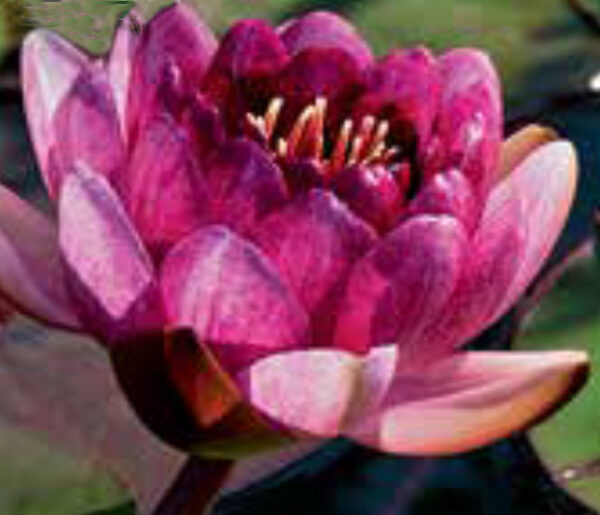This hardy waterlily features deep red flowers nearly black at the center. New lily pads emerge red and mature to green. Very free flowering!
Blooms open to 5-6″ on plants with a mature spread of 6-12′.
Water lilies are easy to grow. Small, pre-formed pools or tubs set into the ground and large ceramic bowls on patios and decks make nice small water features. Of course, they’re also fun to grow in larger ponds!
Water lilies require sun with a minimum of six hours of direct sunlight every day. Plants will survive in less light but flowering will be diminished.
Hardy water lilies are day blooming, so flowers close in late afternoon. They grow best in tranquil, warm water. Avoid fountains and waterfalls that stir up the water.
Hardy water lilies produce rhizomes suited for our hardiness zone and may be left in the water year round so long as the water does not freeze solid. Pools should be at least 24 inches deep to avoid freezing. A water heater can also be used to prevent freezing.
Water lilies require adequate spacing to produce maximum blooms. Leaves may entirely cover the surface of the water, but if fish are kept in the pool you’ll want to prune foliage to allow some open water for air exchange. Remove older leaves and stems first and to allow almost half of the water’s surface to be exposed.
Spring is a great time to plant hardy water lilies. Plant your water lily in a tub or container and then submerge the whole thing into the pool or tub. Large water lilies should be grown in containers no smaller that 12″ x 12″. Dwarf varieties will thrive in 9-10″ pots. Use blocks or bricks to position potted containers in the larger water vessel.
Water lilies grow well in fairly heavy clay soils low in organic matter but they’re heavy feeders. Water lily fertilizer tabs are made from slowly soluble materials to prevent quick release in water. Follow label instructions.
Water lilies are mostly unaffected by diseases and pests. Water-loving dogs can harm them when taking a dip. If you’re lucky you might attract turtles that snack on foliage. Koi also ocassionally nibble leaves.
Divide water lilies when they become crowded in their container, usually every four or five years, depending on how fast your hardy lily grows. Reduced blooming and leaves pushing out above the surface of the water can be indicators that it’s time to divide your rhizomes.
